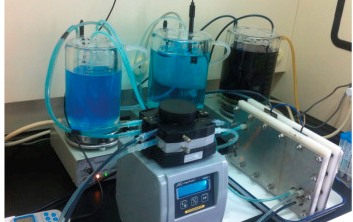侧边栏
Acid blue 9 desalting using electrodialysis
J. Membr. Sci. 2015, 493, pp 28–36 (29 June, 2015)
By Chang Xue, Qing Chen, Yuan-Yuan Liu, Yu-Ling Yang, Dan Xu, Lixin Xue and Wei-Ming Zhang*
10.1016/j.memsci.2015.06.027, local fulltext
Currently nanofiltration predominates the membrane application of dye desalting and purification, and it is very effective to produce low-salt dye from raw dye with high inorganic salt impurities. However it is difficult and costly to produce dye products with ultralow impurities, because the desalting performance decreases proportionally as the concentration of salt impurity decreases. Here in this study, an optimized electrodialysis desalting process was proposed to fill the gap. The dye–membrane interactions, fouling mechanism and abatement strategy were carefully investigated and well understood. Long term system performance stability and reasonable process cost are achieved. Nearly all SO42− in the feed dye can be removed, and residual [Cl−] is only 130 mg/L (~96% removal) in the final aqueous dye product (~200 g/L). The overall purification cost is $0.097/kg as dye solids, which is very economically competitive. The electrodialysis desalting process proposed here provides another feasible and competitive approach for dye desalting and purification other than nanofiltration.


